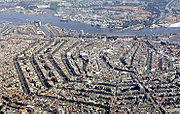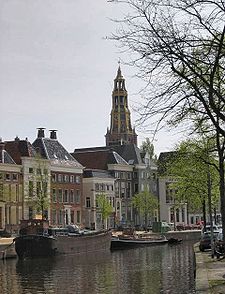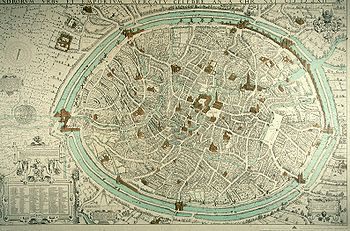
Gracht
Encyclopedia



Dutch language
Dutch is a West Germanic language and the native language of the majority of the population of the Netherlands, Belgium, and Suriname, the three member states of the Dutch Language Union. Most speakers live in the European Union, where it is a first language for about 23 million and a second...
term that is encountered by English-speaking people when confronted with Dutch
Netherlands
The Netherlands is a constituent country of the Kingdom of the Netherlands, located mainly in North-West Europe and with several islands in the Caribbean. Mainland Netherlands borders the North Sea to the north and west, Belgium to the south, and Germany to the east, and shares maritime borders...
art (e.g. 17th century town-views of grachten), Dutch history (Anne Frank House
Anne Frank House
The Anne Frank House on Prinsengracht canal in Amsterdam, the Netherlands, is a museum dedicated to Jewish wartime diarist Anne Frank, who hid from Nazi persecution with her family and four other people in hidden rooms at the rear of the building...
on the Prinsengracht) or tourism (boating tours on the grachten of Amsterdam
Amsterdam
Amsterdam is the largest city and the capital of the Netherlands. The current position of Amsterdam as capital city of the Kingdom of the Netherlands is governed by the constitution of August 24, 1815 and its successors. Amsterdam has a population of 783,364 within city limits, an urban population...
). The word is almost untranslatable; for that reason the following terms kanaal, gracht and singel will be discussed here first.
Three related terms
- A kanaal (canalCanalCanals are man-made channels for water. There are two types of canal:#Waterways: navigable transportation canals used for carrying ships and boats shipping goods and conveying people, further subdivided into two kinds:...
) is a man made water course, usually in the country-side, irrespective of whether it has streets along its banks. - A gracht (city-canal) is a waterway in the city with streets on both sides of the water. The streets are lined with houses, often in a closed front. (In rare exceptions there is only one street, where on the other side of the waterway the houses border on the water, see the photograph "Example of half a gracht".)
- A singel is by origin a water-filled moatMoatA moat is a deep, broad ditch, either dry or filled with water, that surrounds a castle, other building or town, historically to provide it with a preliminary line of defence. In some places moats evolved into more extensive water defences, including natural or artificial lakes, dams and sluices...
which surrounds a city for defense purposes. When the city expands the singel is incorporated in the city’s structure and cannot be distinguished any more from a gracht, although the name ‘singel’ is usually maintained.
Because of their origin, singels often encircle (older) parts of the city. But in other cases regular grachten were dug in circles as well, like the famous grachten-gordel (canal-belt) of Amsterdam.
‘Embankment’ and 'quay' are better translation options for gracht than the word ‘canal’, too much ingrained; perhaps the word ‘gracht’ could better be maintained, whatever the pronunciation.
Function and history
Grachten were the life-lines of Dutch and Flemish cities. They were used for many purposes: for transportation, for draining, for water-winning and as sewers, all at the same time. In heavy populated cities these combined functions repeatedly proved to be detrimental to the public health.Most Hanseatic cities
Hanseatic League
The Hanseatic League was an economic alliance of trading cities and their merchant guilds that dominated trade along the coast of Northern Europe...
have grachten to transport, to load and to land goods in and from ships. Sometimes grachten were made from older rivers, like in Groningen. There the older river called Drentse Aa was used as a natural part of the grachten (showed on the image).
In Delft the main gracht – the Oude Delft – started as a drainage canal for reclaiming land in marshy surroundings.
A function in almost every city was drainage
Drainage
Drainage is the natural or artificial removal of surface and sub-surface water from an area. Many agricultural soils need drainage to improve production or to manage water supplies.-Early history:...
. Rain water flowed through these city-canals. Usually they were also used as a sewer. Because these functions are not needed any more, many grachten have been filled in to give access to road traffic. The names of these new streets are, however, mostly named after the old name of the gracht.
Delft as an example
The history of the city of DelftDelft
Delft is a city and municipality in the province of South Holland , the Netherlands. It is located between Rotterdam and The Hague....
gives us a good impression of how the origins of the grachten (and their precursors) coincide with the origin of a Dutch town.
In a period roughly around the year 1100 a canal was delved here, making use of a natural creek in the marshy country. This canal was called Delf, later on Delft, from the word “delven” that is akin to the verb to “delve” in English. See canal [1] on the accompanying map of Delft. This canal was used for draining the land at both sides; later-on it also served as a waterway for transport.
Afterwards a second canal was dug, called the Nieuwe Delft (New Delft); it went right through part of the settlement that had grown in the meanwhile. See [2] on the map. The original Delf was from that time on called Oude Delft (Old Delft), as it is still today.
The rural village around Oude and Nieuwe Delft developed into a more municipal area and the canals [1] and [2] gradually acquired the character of city-canals or grachten. A third canal [3] was dug and also changed into a gracht; it met the moat of the Market-place and its surroundings, see the map. City-forming and the shaping of the grachten went here hand in hand.
In 1246 this conglomerate acquired city-rights from the Count of Holland and henceforward became the City of Delft.
It is interesting to see that a natural waterway [4] was later-on incorporated in the city and became a gracht as well. Still later, circular canals or singels [S] were dug and surrounded the city. Fortifications were built along these singels and fixed the shape of the historical inner city of Delft.
Characteristic are also the narrower grachten [d], perpendicular to the main grachten. These are the remnants of former ditches that drained and bordered the pre-municipal meadows.
The history of the city of Delft, its grachten, and that of the surrounding countryside are intimately interwoven, like in so many Dutch and Flemish towns.
Etymology
The word gracht stems from the older word graft, which is derived from graven, to dig. The Dutch language has had a sound shift in which the combination -ft became -cht. Other good examples are lucht (German: Luft, sky/air) and zacht (English: soft). In some regional languages like Frisian and GroningsGronings
Gronings, in the dialect itself called Grunnegs or Grönnegs, is a collective name for some Friso-Saxon dialects spoken in the province of Groningen and around the Groningen border in Drenthe and Friesland. Gronings and the strongly related varieties in East-Frisia have a strong Frisian influence...
the word graft is still used.
In Dutch the word gracht is only used when canals are located inside the city, while canals outside a city are called kanaal. However, Venice
Venice
Venice is a city in northern Italy which is renowned for the beauty of its setting, its architecture and its artworks. It is the capital of the Veneto region...
is an exception. In Dutch one does not say "de grachten van Venetië" (the city-canals of Venice), but "de kanalen van Venetië" (the canals of Venice).
Toponyms for grachten are usely made by the suffixes -gracht, -singel (which refers to the old circle-shaped canals), -wal (referring to the bank of the gracht), -vest (referring to a fortification) and -kade (Flemish
Flemish
Flemish can refer to anything related to Flanders, and may refer directly to the following articles:*Flemish, an informal, though linguistically incorrect, name of any kind of the Dutch language as spoken in Belgium....
: -kaai; quay). The suffix -diep is used in Groningen where it is a local word for a large canal.
When a gracht is a remake of an old river, the river's name is used.
Cities in the Netherlands that (still) have grachten
- AlkmaarAlkmaarAlkmaar is a municipality and a city in the Netherlands, in the province of Noord Holland. Alkmaar is well known for its traditional cheese market. For tourists, it is a popular cultural destination.-History:...
- AmersfoortAmersfoortAmersfoort is a municipality and the second largest city of the province of Utrecht in central Netherlands. The city is growing quickly but has a well-preserved and protected medieval centre. Amersfoort is one of the largest railway junctions in the country, because of its location on two of the...
- AmsterdamAmsterdamAmsterdam is the largest city and the capital of the Netherlands. The current position of Amsterdam as capital city of the Kingdom of the Netherlands is governed by the constitution of August 24, 1815 and its successors. Amsterdam has a population of 783,364 within city limits, an urban population...
- BredevoortBredevoortBredevoort or Brevoort is a small city with Town privileges of about 1600 inhabitants, located in the municipality of Aalten, Netherlands. It is situated between the towns of Aalten and Winterswijk....
- DelftDelftDelft is a city and municipality in the province of South Holland , the Netherlands. It is located between Rotterdam and The Hague....
- DeventerDeventerDeventer is a municipality and city in the Salland region of the Dutch province of Overijssel. Deventer is largely situated on the east bank of the river IJssel, but also has a small part of its territory on the west bank. In 2005 the municipality of Bathmen Deventer is a municipality and city in...
- DordrechtDordrechtDordrecht , colloquially Dordt, historically in English named Dort, is a city and municipality in the western Netherlands, located in the province of South Holland. It is the fourth largest city of the province, having a population of 118,601 in 2009...
- GoudaGoudaGouda is a city and municipality in the western Netherlands, in the province of South Holland. Gouda, which was granted city rights in 1272, is famous for its Gouda cheese, smoking pipes, and 15th-century city hall....
- Groningen
- HaarlemHaarlemHaarlem is a municipality and a city in the Netherlands. It is the capital of the province of North Holland, the northern half of Holland, which at one time was the most powerful of the seven provinces of the Dutch Republic...
- HarlingenHarlingen, NetherlandsHarlingen is a municipality and a city in the northern Netherlands, in the province of Friesland at the Wadden Sea. Harlingen is an old town with a long history of fishing and shipping....
- HindeloopenHindeloopen-External links:* Museum Hindeloopen: Hindelooper schilderkunst, klederdracht, stads- en scheepvaarthistorie.*...
- The HagueThe HagueThe Hague is the capital city of the province of South Holland in the Netherlands. With a population of 500,000 inhabitants , it is the third largest city of the Netherlands, after Amsterdam and Rotterdam...
- 's-Hertogenbosch
- HoornHoorn-Cities :* Purmerend * Enkhuizen * Alkmaar * Amsterdam * Lelystad * Den Helder * Leeuwarden -Towns :* Edam...
- KampenKampen (Overijssel)Kampen is a municipality, a city and an old Hanseatic city at the lower reaches of the river IJssel in the Dutch province of Overijssel.The municipality of Kampen counts 50,073 inhabitants in an area of approximately 162 km² . Kampen is located in the North West of Overijssel and is the...
- Leeuwarden
- Leiden
- MeppelMeppelMeppel is a municipality and a city in the northeast of the Netherlands, in the south-west of the province Drenthe.It developed in the 16th century as a transport and distribution inland harbour for turf...
- MiddelburgMiddelburgMiddelburg is a municipality and a city in the south-western Netherlands and the capital of the province of Zeeland. It is situated in the Midden-Zeeland region. It has a population of about 48,000.- History of Middelburg :...
- RotterdamRotterdamRotterdam is the second-largest city in the Netherlands and one of the largest ports in the world. Starting as a dam on the Rotte river, Rotterdam has grown into a major international commercial centre...
- SneekSneekSneek is a city southwest of Leeuwarden and seat of the former municipality of Sneek in the province of Friesland . As for 2011 it is part of the municipality Súdwest Fryslân...
- UtrechtUtrecht (city)Utrecht city and municipality is the capital and most populous city of the Dutch province of Utrecht. It is located in the eastern corner of the Randstad conurbation, and is the fourth largest city of the Netherlands with a population of 312,634 on 1 Jan 2011.Utrecht's ancient city centre features...
- Zutphen
- ZwolleZwolleZwolle is a municipality and the capital city of the province of Overijssel, Netherlands, 120 kilometers northeast of Amsterdam. Zwolle has about 120,000 citizens.-History:...
Trivia
When the citizens of Amsterdam decided in the 17th century to extend their town, they dug their city canals in semicircles around the old centre. On each canal or gracht were tree-lined streets on both sides of the water. But these proud Amsterdam citizens were quite the jokers. They called the first and paramount gracht after themselves: the Heerengracht: the gracht of the Heeren, the Masters of Amsterdam.The second one they called the Keizersgracht: the gracht of the Emperors; and the third one, further from the centre, the Prinsengracht: the gracht of the Princes. In that way they indicated that the Heeren – being themselves – were more important than Emperors, who are (of course) more important than Princes. A kind of practical joke.
One can wonder whether the emperors of Europe ever resented that joke when they visited Amsterdam. It can, however, surely be assumed they didn’t. In the course of time several emperors have visited the town and none of them ever complained, the joke is well hidden in Amsterdam’s street plan.
Sources
EtymologyP.A.F van Veen & N. van der Sijs, Etymologisch Woordenboek (Etymologic Dictionary)
Van Dale, Utrecht 1997
Grachten
it proves to be difficult to find general literature on Dutch city-canals, grachten, or singels. The history of these canals is, however, embedded in the history of their towns so that links to Dutch cities and their history may provide the information we are looking for:
- Amsterdam History of AmsterdamHistory of AmsterdamAmsterdam has a long and eventful history. The origins of the city lie in the 13th century, when fisherman living along the banks of the River Amstel built a bridge across the waterway near the IJ, then a large saltwater inlet. Wooden doors on the bridge served as a dam; these protected the town...
- Haarlem Haarlem#History
- Alkmaar 1573 http://commons.wikimedia.org/wiki/File:Almaar_1573.jpg
- Amersfoort
- Delft http://wikitravel.org/en/Delft#Understand and http://commons.wikimedia.org/wiki/File:Delft_-_Delfi_Batavorum_vernacule_Delft_(1649).jpg
- Delft: J.F Niermeyer, Delft and Delfland, Leiden 1944
- Gouda GoudaGoudaGouda is a city and municipality in the western Netherlands, in the province of South Holland. Gouda, which was granted city rights in 1272, is famous for its Gouda cheese, smoking pipes, and 15th-century city hall....
- The Hague 1652
- Leiden Leiden#16th and 17th centuries and Leiden#Rivers, canals and parks

